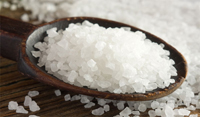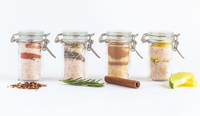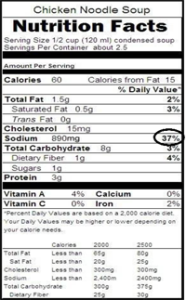Learning about salt, otherwise known as sodium chloride is very useful in managing your wellness plan. Salt is made of 40% sodium and 60% chloride. Salt is used to add flavor to food. It is also used as a preservative, binder and stabilizer. Salt is necessary to the human body to conduct nerve impulses, contract and relax muscles and retain the proper balance of water and minerals. While the human body needs only a small amount of sodium to do its job, salt also makes our food taste good….and not all salt is created equal. There are many types to choose from with different tastes, textures and mineral and sodium content. Most of the world’s salt is harvested from salt mines or by evaporating sea water or other mineral-rich waters.
In this article I hope to share with you information about several types of salts you may choose to cook with, as well as some information about how to be mindful of your intake and concerns you might have about consuming too much sodium.
 Refined Salt (Table Salt)
Refined Salt (Table Salt)
Plain old table salt is usually highly refined. It is highly ground and most of the impurities and trace minerals are removed. When you ground salt in this manner it tends to stick together, so during the processing, anti-caking agents are added. Iodine is often added to table salt as a public health measure against iodine deficiency which can cause several health problems like hypothyroidism and mental retardation.
If you choose to avoid iodine-enriched table salt, you can ensure proper amounts of iodine in your body by eating foods that are high in iodine like fish, dairy, eggs and seaweed.
 Fleur de Sel
Fleur de Sel
Fleur de Sel literally means “Flower of Salt” in French. Fleur de Sel is a special occasion table salt that should be served in a salt cellar to be pinched, then sprinkled over food just before eating. It has a delicate, earthy flavor that lingers on the tongue. Fleur de Sel is a solar evaporated sea, lake, or spring salt with fine, irregular, moist, mineral-rich crystals which are hand harvested by raking the crystals that blossom on the surface of a crystallizing pan. It is best used for foods with subtle flavors.
Sel Gris is a type of Fleur de Sel that is gray in color and has hefty, moist crystals. Sel Gris has a deep, mineral crunch that is best suited for steaks, chops, roasts, beans, roots and other hearty vegetable dishes.
Flaked Sea Salt
Flaked Sea Salt is the fastest dissolving of all the salt grains and had a soft, sheer, pyramid-like flake. To add a complex briny flavor to salads, steamed veggies or seafood, crush the crystals between your fingertips and sprinkle them on freshly cooked food.
 Crystalline Sea Salt
Crystalline Sea Salt
Crystalline Sea Salt can be found on both the Pacific and Atlantic Coasts on North and South America. It is best used to add pungent flavor to just cooked food. Crystalline Sea Salt can be found both in fine or course textures, depending on the natural impurities that vary depending on where it is found, it can be sweet, briny or bitter and can be different colors.
 Sea salt combined with spices and herbs or other flavors are known as Infused Salts. Flavors include Black Truffle with its woody garlic flavor, Lemon Flake has a pungent, sweet lemon flavor, Saffron Salt has a floral and peppery flavor and many others. Each one is best used on lighter flavored food items like salads, steamed veggies, eggs and some desserts.
Sea salt combined with spices and herbs or other flavors are known as Infused Salts. Flavors include Black Truffle with its woody garlic flavor, Lemon Flake has a pungent, sweet lemon flavor, Saffron Salt has a floral and peppery flavor and many others. Each one is best used on lighter flavored food items like salads, steamed veggies, eggs and some desserts.
 Smoked Salt is a sea salt that has been cold-smoked with hardwood for a smoky woodsy color and scent. Smoked Salt can be used on anything from popcorn to salmon or chocolate mouse.
Smoked Salt is a sea salt that has been cold-smoked with hardwood for a smoky woodsy color and scent. Smoked Salt can be used on anything from popcorn to salmon or chocolate mouse.
Shio Salt is a a Japanese salt made by evaporating seawater over fire, in a greenhouse or other ways and then crystallized over fire. This process creates very fine granular crystals with a complex, clean taste that allows the flavors of the food to stand out. Shio Salt is great for sandwiches, broth, sashimi, popcorn or steamed vegetables.
 Celtic Salt is a type of salt that originated in France. It is grayish in color and contains a bit of water, which keeps it moist. Celtic Salt contains trace amounts of minerals and has a slightly lower amount of sodium than Table Salt.
Celtic Salt is a type of salt that originated in France. It is grayish in color and contains a bit of water, which keeps it moist. Celtic Salt contains trace amounts of minerals and has a slightly lower amount of sodium than Table Salt.
Kosher Salt
Kosher Salt dissolves quickly and it is useful for all types of cooking. Kosher salt can come from the sea or the earth. Kosher Salt has coarse crystals that are perfect for curing meat, which is a step in the koshering process which is where its name is derived from.
Kosher Salt has a large flake size and tends to not contain additives like anti-caking agents and iodine.
Rock Salt
Rock Salt is used for regulating the temperature in old-fashioned hand-cranked ice cream makers and also for deicing your sidewalk and driveway in the winter. This type of Rock Salt is mined from deposits in the earth and its large, nonuniform crystals are gray in color. It is not sold to be used directly on food.

Himalayan Pink Salt is another version of Rock Salt harvested in Pakistan. It is made from oceans that dried up tens or hundreds of millions of years ago that have left behind their salt that has been compressed under the earth’s crust. Himalayan Pink Salt has hard, dry crystals with moderately high mineral content (iron oxide, calcium, iron, potassium and magnesium). Usually Himalayan Pink Salt is ground up mechanically and used for a finishing salt for an intense flavor.
Pickling Salt
Pickling Salt is used for brining pickles and sauerkraut. Pickling salt is very concentrated compared to kosher salt so use less if you are brining turkey. Pickling Salt is the purest of all salt, it is not fortified with iodine and does not contain anti-caking chemicals. Pickling Salt is fine-grained, like Table Salt.
 Read The Label
Read The Label
Many Americans live with high blood pressure. If not treated high blood pressure can cause many serious health concerns. High blood pressure can be caused or made worse by a diet that is high in salt, however you might be surprised that 75% of dietary sodium comes from processed and packaged or restaurant foods, while only 11% of sodium comes from adding salt to your food.
Even foods that do not taste salty can have a lot of sodium in them so it is important to learn how to read Nutrition Facts Labels.
- The Daily Value, or recommended amount of nutrients, for sodium is less than 2,400 mg per day.
- Based on the 100% Daily Value for sodium, %DV tells you how much sodium is in one serving of a food. For instance, 5% DV or less of sodium per serving is low; 20% DV or more of sodium is considered high.
- Many times there is more than one serving of food in a packaged item. If a package of food contains 2 servings of food and you eat all of it, you have consumed 2 times the amount of sodium listed on the package.
Salt and Sodium
Salt and Sodium do not mean the same thing. Sodium is a mineral and one of the chemical elements found in salt. Salt or sodium chloride is a compound found in nature that is used to flavor and preserve food.
The Standard American Diet can be heavy in sodium. Much of the sodium we consume comes from bread, chicken, pizza, lunchmeat, snack foods and processed foods. Diets high in salt can contribute to kidney stones, dry eye disease, obesity, high blood pressure and diseases related to high blood pressure.
High Blood Pressure
A high-sodium diet draws water into the bloodstream and may increase your blood pressure because it increases the volume of blood in your blood stream. High blood pressure, also called hypertension, makes your heart work harder, which can harm arteries and organs including the heart, kidneys, brain and eyes, causing in some people, heart disease and stroke. As we age blood pressure rises so it is wise to limit your sodium intake as you age.
 Eating foods high in potassium can help balance out the effects sodium may have on blood pressure. Foods that are rich in potassium are:
Eating foods high in potassium can help balance out the effects sodium may have on blood pressure. Foods that are rich in potassium are:
- bananas
- beet greens
- carrot, orange, pomegranate and prune juices
- yogurt
- potatoes
- spinach
- sweet potatoes
- tomatoes
- white beans
- coconuts
- kale
If you have high blood pressure it is important for you to eat less than 100% of the Daily Value for sodium, or less than 2,400 mg per day.
People who are at a higher risk of high blood pressure are:
- People over age 50
- People who have high or slightly elevated blood pressure
- People who have diabetes
- African Americans
Eat Less Sodium: Here are some ways to decrease the amount of sodium you are eating.
- Read Nutrition Facts Labels
- Prepare your food from scratch when you can. Avoid mixes, instant or packaged foods and sauces.
- Add flavor without adding sodium by using no-salt seasonings, herbs, lemon juice or vinegars.
- Buy fresh meats, poultry and seafood instead of processed foods. Also read labels to see if salt water or saline has been added.
- Buy fresh, frozen or low sodium or no-salt-added canned vegetables.
- Rinse canned foods like beans, tuna and vegetables before eating to remove some of the sodium.
- Eat low sodium or no-salt-added snacks like carrots or celery sticks, nuts, and seeds.
- Remember that condiments have sodium in them too and this can add up. Consider using olive oil and vinegar on salads instead of bottled dressings and when using flavor packets, try not using the entire amount.
- Eat less. Prepare small portions at home and when going out choose smaller sizes or consider sharing an entree or taking home part of your meal.
- When eating out ask that meals be prepared without salt and ask that sauces and dressings be on the side so you can choose to use less.
In the end, I hope I shared with you something you didn’t know about salt before you read this article. All salt has sodium which adds flavor but if used too often may increase your chance of serious health issues. I would like to encourage you to consider more natural types of salt without additives to add great flavor to your food and eat a well-balanced diet that includes lots of vegetables that are high in potassium and iodine to maintain your optimum health.
If you would like some help creating your wellness plan and diet plan Contact Wellness Works. Karen G Clemenson is happy to schedule a free initial consultation. Wellness Works NW is located in Longview, Washington and serves Cowlitz County and the surrounding areas.
Read more at:
- Chasing Wellness with Jamie Holloway: Learning About High Blood Pressure
- Authority Nutrition: Types of Salt: Himalayan vs Kosher vs Regular vs Sea Salt
- Harvard T.H. Chan: Salt and Sodium
- NutrionFacts.org: Sodium
- Real Simple: 6 Types of Salt and How to Use Them
- The Meadow: Salt 101
- U.S. Food and Drug Administration: Sodium in Your Diet: Use the Nutrition Facts Label and Reduce Your Intake
 Summer D Clemenson co-owns Clemenson Enterprises and Wellness Works NW with her wife, Karen G Clemenson. Their personal motto is Creativity, Honesty & Positivity are a must! This mantra helps them stay community and wellness minded in all they do. Summer also writes poetry and inspirational blogs @ ClemensonEnterprises.com. Her crochet art can be viewed and purchased @ KnottyWares.com & she loves special orders!
Summer D Clemenson co-owns Clemenson Enterprises and Wellness Works NW with her wife, Karen G Clemenson. Their personal motto is Creativity, Honesty & Positivity are a must! This mantra helps them stay community and wellness minded in all they do. Summer also writes poetry and inspirational blogs @ ClemensonEnterprises.com. Her crochet art can be viewed and purchased @ KnottyWares.com & she loves special orders!



 Please wait...
Please wait...

